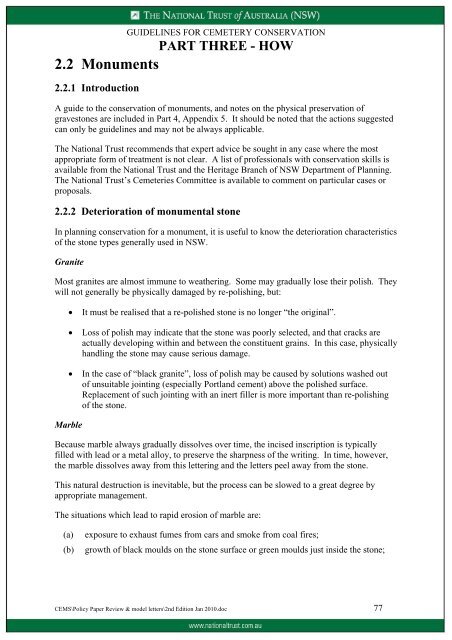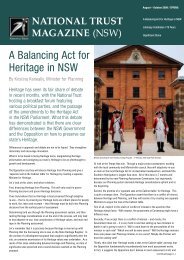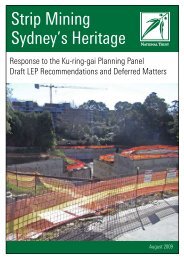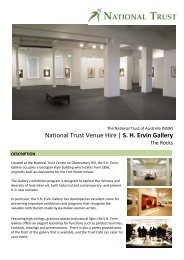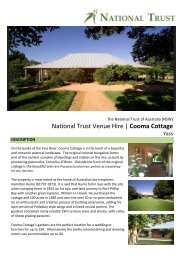Guidelines for Cemetery Conservation - National Trust of Australia
Guidelines for Cemetery Conservation - National Trust of Australia
Guidelines for Cemetery Conservation - National Trust of Australia
You also want an ePaper? Increase the reach of your titles
YUMPU automatically turns print PDFs into web optimized ePapers that Google loves.
GUIDELINES FOR CEMETERY CONSERVATION<br />
PART THREE - HOW<br />
2.2 Monuments<br />
2.2.1 Introduction<br />
A guide to the conservation <strong>of</strong> monuments, and notes on the physical preservation <strong>of</strong><br />
gravestones are included in Part 4, Appendix 5. It should be noted that the actions suggested<br />
can only be guidelines and may not be always applicable.<br />
The <strong>National</strong> <strong>Trust</strong> recommends that expert advice be sought in any case where the most<br />
appropriate <strong>for</strong>m <strong>of</strong> treatment is not clear. A list <strong>of</strong> pr<strong>of</strong>essionals with conservation skills is<br />
available from the <strong>National</strong> <strong>Trust</strong> and the Heritage Branch <strong>of</strong> NSW Department <strong>of</strong> Planning.<br />
The <strong>National</strong> <strong>Trust</strong>’s Cemeteries Committee is available to comment on particular cases or<br />
proposals.<br />
2.2.2 Deterioration <strong>of</strong> monumental stone<br />
In planning conservation <strong>for</strong> a monument, it is useful to know the deterioration characteristics<br />
<strong>of</strong> the stone types generally used in NSW.<br />
Granite<br />
Most granites are almost immune to weathering. Some may gradually lose their polish. They<br />
will not generally be physically damaged by re-polishing, but:<br />
• It must be realised that a re-polished stone is no longer “the original”.<br />
• Loss <strong>of</strong> polish may indicate that the stone was poorly selected, and that cracks are<br />
actually developing within and between the constituent grains. In this case, physically<br />
handling the stone may cause serious damage.<br />
• In the case <strong>of</strong> “black granite”, loss <strong>of</strong> polish may be caused by solutions washed out<br />
<strong>of</strong> unsuitable jointing (especially Portland cement) above the polished surface.<br />
Replacement <strong>of</strong> such jointing with an inert filler is more important than re-polishing<br />
<strong>of</strong> the stone.<br />
Marble<br />
Because marble always gradually dissolves over time, the incised inscription is typically<br />
filled with lead or a metal alloy, to preserve the sharpness <strong>of</strong> the writing. In time, however,<br />
the marble dissolves away from this lettering and the letters peel away from the stone.<br />
This natural destruction is inevitable, but the process can be slowed to a great degree by<br />
appropriate management.<br />
The situations which lead to rapid erosion <strong>of</strong> marble are:<br />
(a)<br />
(b)<br />
exposure to exhaust fumes from cars and smoke from coal fires;<br />
growth <strong>of</strong> black moulds on the stone surface or green moulds just inside the stone;<br />
CEMS\Policy Paper Review & model letters\2nd Edition Jan 2010.doc 77


